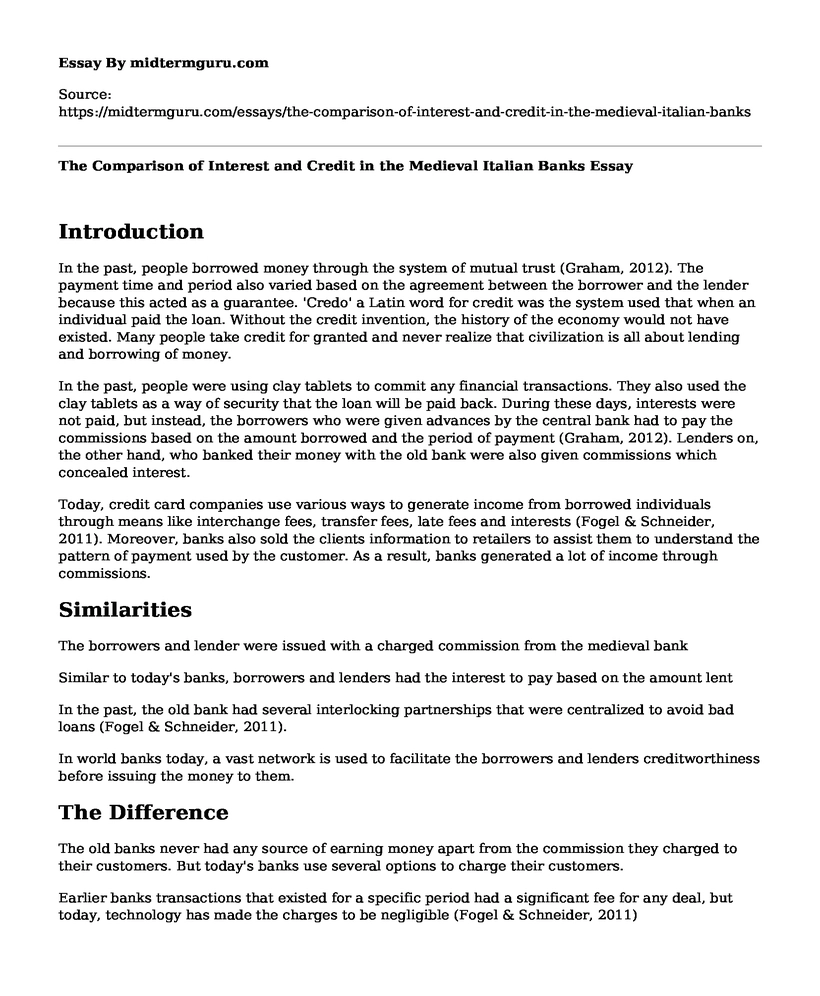Introduction
In the past, people borrowed money through the system of mutual trust (Graham, 2012). The payment time and period also varied based on the agreement between the borrower and the lender because this acted as a guarantee. 'Credo' a Latin word for credit was the system used that when an individual paid the loan. Without the credit invention, the history of the economy would not have existed. Many people take credit for granted and never realize that civilization is all about lending and borrowing of money.
In the past, people were using clay tablets to commit any financial transactions. They also used the clay tablets as a way of security that the loan will be paid back. During these days, interests were not paid, but instead, the borrowers who were given advances by the central bank had to pay the commissions based on the amount borrowed and the period of payment (Graham, 2012). Lenders on, the other hand, who banked their money with the old bank were also given commissions which concealed interest.
Today, credit card companies use various ways to generate income from borrowed individuals through means like interchange fees, transfer fees, late fees and interests (Fogel & Schneider, 2011). Moreover, banks also sold the clients information to retailers to assist them to understand the pattern of payment used by the customer. As a result, banks generated a lot of income through commissions.
Similarities
The borrowers and lender were issued with a charged commission from the medieval bank
Similar to today's banks, borrowers and lenders had the interest to pay based on the amount lent
In the past, the old bank had several interlocking partnerships that were centralized to avoid bad loans (Fogel & Schneider, 2011).
In world banks today, a vast network is used to facilitate the borrowers and lenders creditworthiness before issuing the money to them.
The Difference
The old banks never had any source of earning money apart from the commission they charged to their customers. But today's banks use several options to charge their customers.
Earlier banks transactions that existed for a specific period had a significant fee for any deal, but today, technology has made the charges to be negligible (Fogel & Schneider, 2011)
Early money lenders never appreciated much for their services but today borrowers respect the lenders
Criteria Used by Medieval Banks to Establish Creditworthiness
Ever since the past, banks and moneylenders found different approaches to determine the solvency of the borrower (Graham, 2012). For instance, the method the old banks have been using since then is still used today while issuing a loan is a co-signer. In the financial world today, the co-signers air guarantee worthiness was determined with their income. Individuals in this case that had sufficient ways of paying the loan in cases when the borrower fails to pay were the ones known as the right or adequate people (Rose et al., 2016). Such people were judged based on the clothes they wore. If the material of the cloth was of high quality, it meant that they were people of worth. This system also checked for the food they ate. Lastly, they also tested for luxury items. During the medieval times, such items included things like houses, jewelry, meals, and clothes to determine their ability to repay the loan (Graham, 2012). Any individual that never had such quality was not considered to have the money of clearing any credit.
References
Ferguson, N. (2009). The ascent of money. Retrieved from https://www.youtube.com/watch?v=fsrtB5lp60s
Fogel, J., & Schneider, M. (2011). Credit card use: Disposable income and employment status. Young Consumers, 12(1), 5-14. doi:10.1108/17473611111114740
Graham, D. (2012). The Insolvent Italian Banks of Medieval London: Part I. International Insolvency Review, 9(2), 147-156. doi:10.1002/1099-1107(200022)9:23.0.co;2-7
Ross, S. A., Westerfield, R., Jordan, B. D., & Roberts, G. S. (2016). Fundamentals of corporate finance (9th Canadian ed.). Whitby, Canada: McGraw-Hill Ryerson.
Cite this page
The Comparison of Interest and Credit in the Medieval Italian Banks. (2022, Sep 13). Retrieved from https://midtermguru.com/essays/the-comparison-of-interest-and-credit-in-the-medieval-italian-banks
If you are the original author of this essay and no longer wish to have it published on the midtermguru.com website, please click below to request its removal:
- Summary of Case 66C: Alvin Bruce and Square One Inc
- Brief Summary of the Organization: The World Food Program USA
- Questions and Problems on Company's Gross Profit
- Questions and Answers on Capital Budgeting - Paper Example
- Target Acquisition Firms and Financial Performance of BCB Berhad and IWCITY Berhad - Paper Example
- Research Paper on Ratio and Financial Statement Analysis
- Trump's Tax Reforms: Promises Fulfilled After 3 Decades - Essay Sample







